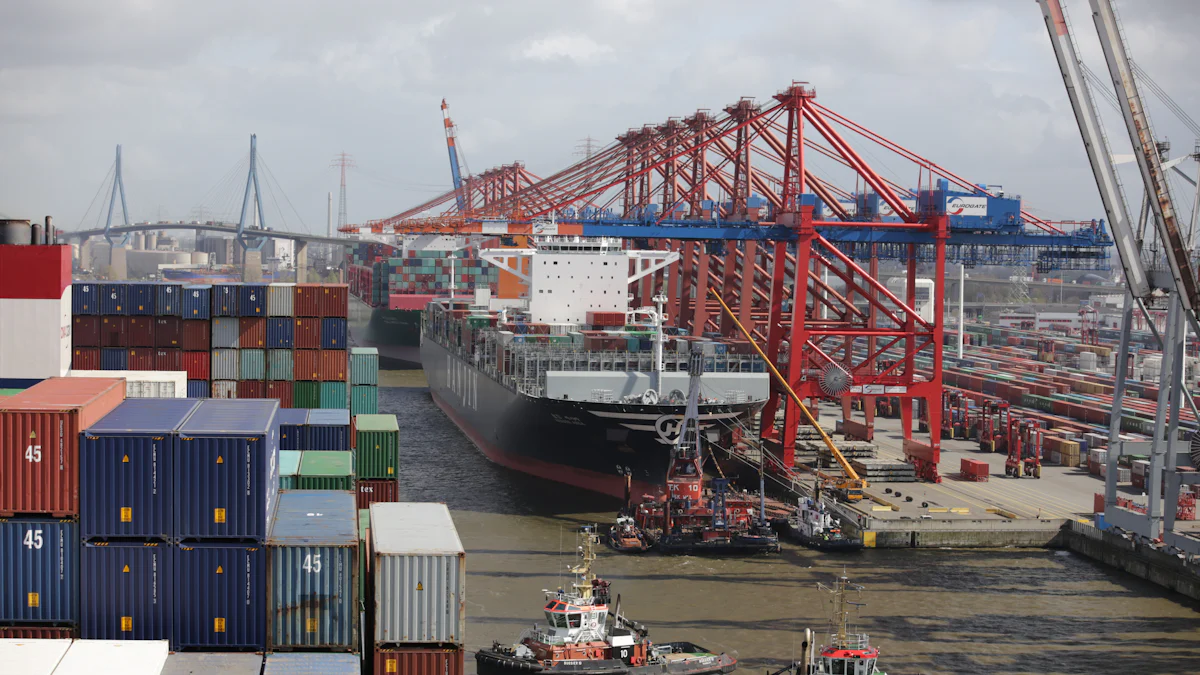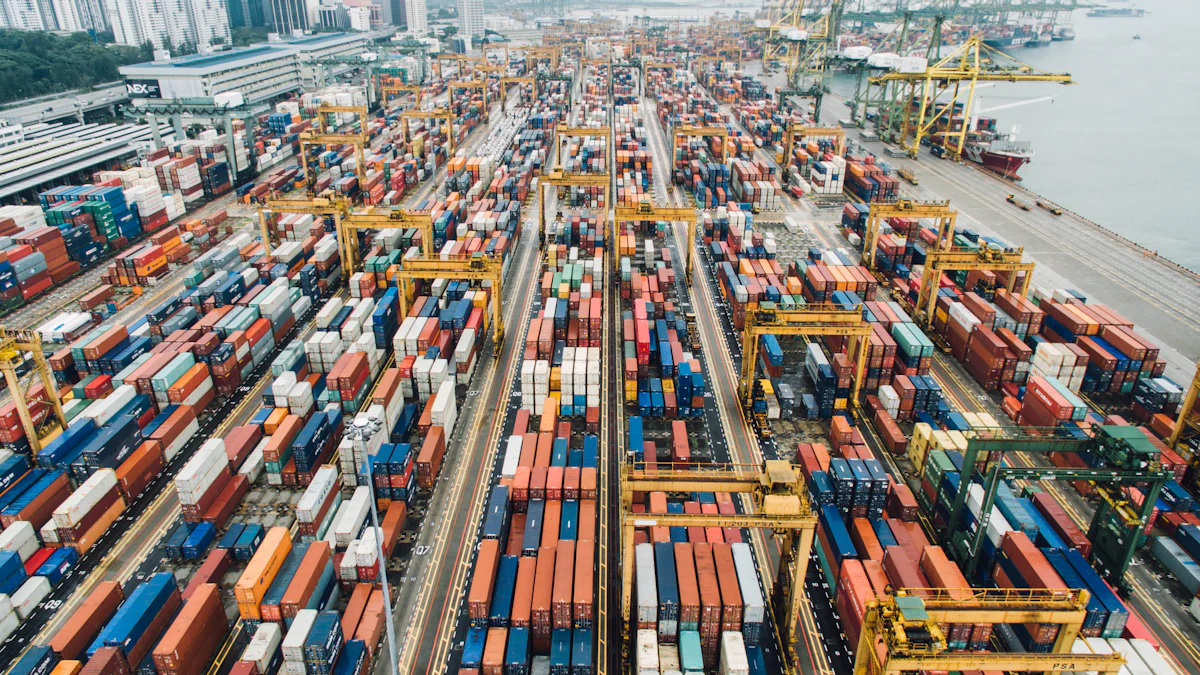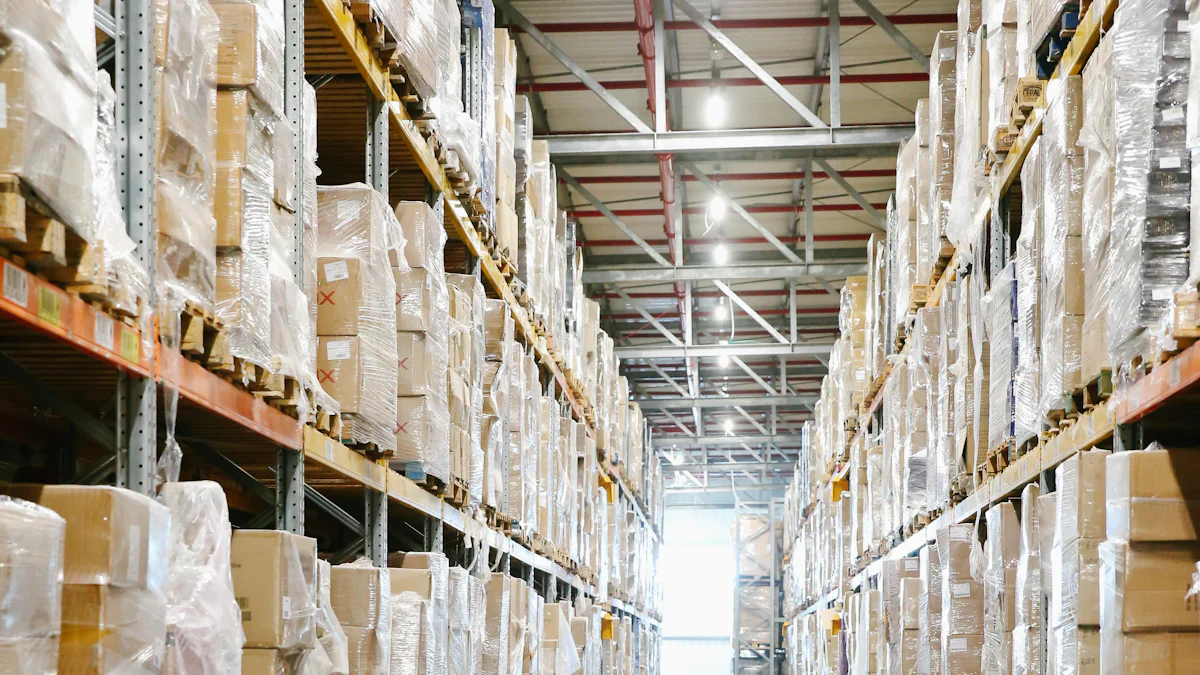Understanding End-to-End Supply Chain Optimization

End-to-end supply chain optimization integrates every step of the supply chain, from procurement to delivery, to improve efficiency and customer satisfaction. This approach enhances visibility, enabling better inventory management and reducing production delays. It also stabilizes costs by minimizing disruptions, leading to increased cost-effectiveness. Real-time data analytics further support smarter decision-making, ensuring operational improvements.
JUSDA stands out as a leader in supply chain optimization. Its global reach and local expertise allow tailored solutions that enhance efficiency and customer satisfaction. The JusLink Smart Supply Chain Management Platform, powered by advanced technologies, showcases JUSDA's commitment to innovation. By adopting end-to-end supply chain optimization, businesses can achieve faster shipping, higher-quality products, and a more sustainable future.

SMART JusLink
Supply Chain Management Solution
Why End-to-End Supply Chain Optimization Matters
Key Benefits of Supply Chain Optimization
Cost Savings and Efficiency
Supply chain optimization helps you reduce costs by streamlining operations and improving processes. By minimizing disruptions, you can stabilize expenses and achieve better productivity. For example, real-time data analytics allow you to make smarter decisions, which enhances efficiency across your supply chain. Improved visibility also ensures better inventory management and order fulfillment, leading to cost-effectiveness. Companies that adopt optimization strategies often experience bottom-line improvements through reduced operating costs and better logistics.
Enhanced Customer Experience
When you optimize your supply chain, your customers benefit directly. Faster shipping and higher-quality products improve satisfaction and loyalty. Streamlined operations ensure that you meet customer demands promptly, which strengthens your reputation in the market. Enhanced efficiency in supply chain management also allows you to deliver consistent results, building trust with your customers over time.
Sustainability and Environmental Impact
Sustainability is a growing priority for businesses. Supply chain optimization supports this goal by reducing waste and lowering carbon emissions. Efficient transportation routes minimize miles traveled, while energy-efficient warehouses cut emissions and save costs. Adopting sustainable packaging and embracing a circular economy further reduce environmental harm. These practices not only benefit the planet but also enhance your brand image as a responsible business.
Competitive Edge in Supply Chain Management
Faster Time-to-Market
In today’s fast-paced market, speed is crucial. Optimized supply chains enable you to bring products to market faster by eliminating inefficiencies. Simplified supplier onboarding and better production scheduling ensure that you stay ahead of competitors. This agility allows you to seize new opportunities and respond quickly to changing customer demands.
Improved Risk Management
Effective risk management is essential for maintaining a resilient supply chain. By conducting regular risk assessments, you can identify potential issues early and develop strategies to address them. For instance, maintaining inventory buffers ensures product flow during disruptions. Enhancing vendor visibility helps you monitor third-party suppliers and mitigate risks. Companies like Toyota have successfully reduced supply chain disruptions by diversifying suppliers and expanding local manufacturing. These strategies protect your operations and ensure long-term stability.
Solving Business Challenges with Supply Chain Optimization
Addressing Inventory Issues
Inventory challenges can disrupt your operations and impact customer satisfaction. Common issues include stockouts, overstocking, and inaccurate demand forecasting. Stockouts occur when you underestimate demand or delay reordering, leading to lost sales and unhappy customers. Overstocking ties up capital and increases storage costs. Inaccurate forecasting, often caused by outdated methods or insufficient data, creates stock imbalances. Managing inventory across multiple sales channels can also be difficult, resulting in overselling or stockouts.
Supply chain optimization helps you overcome these challenges. By leveraging real-time data and advanced analytics, you can achieve better inventory management. This ensures you maintain optimal stock levels, reduce waste, and improve order fulfillment. Enhanced visibility across your supply chain also allows you to track inventory in real time, minimizing errors and improving inventory control.
Streamlining Transportation and Logistics
Efficient transportation and logistics are essential for a smooth supply chain. Strategies like route optimization and load planning reduce transportation costs and improve delivery times. Carrier selection ensures you receive the best service at competitive rates. Real-time tracking enhances visibility, allowing you to respond quickly to issues. Performance analytics provide insights for continuous improvement.
Integrating a Transportation Management System (TMS) further enhances supply chain optimization. A TMS gives you access to real-time data, enabling informed decisions. Strong carrier partnerships and effective inventory control also play a key role. These strategies reduce costs, navigate disruptions, and improve customer satisfaction.
Strategy | Benefits |
|---|---|
Route Optimization | Reduces transportation costs and improves delivery times. |
Load Planning | Maximizes vehicle capacity and minimizes trips. |
Carrier Selection | Ensures the best service and cost efficiency. |
Real-time Tracking | Enhances visibility and responsiveness to issues. |
Performance Analytics | Provides insights for continuous improvement. |
Improving Demand Forecasting Accuracy
Accurate demand forecasting is vital for supply chain optimization. Traditional methods often fall short due to limited data and outdated techniques. Advanced methods like demand sensing and predictive sales analytics offer better results. Demand sensing uses machine learning to detect real-time demand changes, helping you respond to unplanned variations. Predictive sales analytics combines historical and new data to forecast demand, providing deeper insights into customer behavior.
Market research and the Delphi method involve gathering consumer feedback and expert opinions. These approaches require significant resources but deliver valuable insights. External macro forecasting analyzes economic trends to predict demand shifts. By adopting these advanced techniques, you can improve forecasting accuracy, reduce stock imbalances, and enhance overall supply chain performance.
Reducing Operational Costs
Reducing operational costs is a critical goal for businesses aiming to improve profitability. Supply chain optimization offers several strategies to achieve this. Streamlining processes and adopting advanced technologies enhance operational efficiency. For instance, supply chain software provides real-time updates, helping you identify inefficiencies and address them promptly. Inventory analytics also play a vital role by enabling data-driven decisions that reduce waste and improve profitability.
To further reduce costs, you can focus on specific areas:
Manage raw material costs effectively by negotiating better deals with suppliers.
Optimize transportation methods to lower expenses and improve delivery times.
Refine procurement processes to secure competitive pricing.
Implement inventory policies that minimize holding costs and prevent overstocking.
Analyze distribution costs to identify savings opportunities.
Enhance forecasting and demand planning to align supply with demand.
Maintain high customer service levels while managing expenses.
Comprehensive employee training ensures these strategies are executed effectively. Well-trained staff can identify cost-saving opportunities and implement solutions efficiently. By focusing on these methods, you can achieve significant cost reduction while maintaining operational efficiency.
Enhancing Supply Chain Visibility
Supply chain visibility is essential for successful supply chain optimization. It improves data availability for stakeholders, enabling better decision-making and planning. Real-time tracking and monitoring allow you to identify potential issues early and resolve them before they escalate. This reduces inefficiencies and inventory losses, ensuring streamlined operations.
Enhanced visibility also strengthens customer satisfaction. Accurate and timely product delivery builds trust and loyalty. Tailored solutions based on your organization’s needs give you a competitive advantage. For example, better planning and reporting capabilities improve client relations and support strategic decision-making.
By adopting technologies like IoT and supply chain software, you can achieve greater visibility. These tools provide real-time insights into your supply chain, helping you monitor performance and make informed decisions. Improved visibility not only enhances operational efficiency but also positions your business for long-term success.
Technology’s Role in Supply Chain Optimization

Tools and Techniques for Optimization
Artificial Intelligence and Machine Learning
Artificial intelligence and machine learning have transformed supply chain optimization. These technologies enhance decision-making by analyzing vast amounts of data quickly and accurately. For example, ASOS uses machine learning to forecast demand, allowing dynamic inventory adjustments and reducing waste. DHL employs machine learning through Resilience360 to assess risks like cyberattacks and natural disasters, improving logistics decisions. Studies show that 61% of manufacturing executives report cost reductions due to AI, while 53% see revenue increases. By adopting AI, you can improve supply chain visibility and streamline operations.
IoT for Real-Time Monitoring
The Internet of Things (IoT) enables real-time monitoring of supply chains. IoT sensors track inventory, monitor transportation conditions, and provide alerts for potential issues. A cold chain management firm used IoT-enabled temperature monitoring to reduce spoilage rates from 10% to 2%, preserving product quality and increasing customer trust. Businesses adopting IoT solutions report a 25% reduction in operational costs and a 30% improvement in inventory accuracy. These benefits make IoT a vital tool for supply chain optimization.
Data Analytics for Smarter Decisions
Data analytics provides the foundation for smarter decisions in supply chain management. Predictive analytics helps you forecast demand, optimize inventory levels, and reduce risks. For instance, analyzing historical sales data and market trends improves demand forecasting, minimizing stockouts and overstocking. Data-driven insights also enhance transportation planning by identifying optimal delivery routes. By leveraging data analytics, you can achieve greater efficiency and cost savings across your supply chain.
Blockchain for Transparency and Trust
Blockchain technology enhances transparency and trust in supply chains. It creates a digital ledger of transactions that is immutable and accessible to all participants. This ensures product authenticity and traceability. For example, blockchain allows real-time tracking of goods, enabling you to verify each step of the supply chain. Permanent records also reduce the risk of fraud. By adopting blockchain, you can build trust with customers and partners while improving supply chain integrity.
Actionable Steps for Businesses
Adopting Supply Chain Management Software
Supply chain management software simplifies operations and enhances efficiency. It provides real-time data for better decision-making, reduces waste, and improves cash flow management. For example, balancing inventory levels with software minimizes holding costs and prevents cash flow issues. A table below highlights the benefits:
Benefit | Description |
|---|---|
Improved Decision-Making | Real-time data enables informed decisions about stock and supplier negotiations. |
Reduced Waste and Improved Efficiency | Identifying waste leads to lower production costs. |
Enhanced Cash Flow Management | Visibility into the supply chain helps manage cash flow effectively. |
Better Customer Service | Improved communication about order status enhances customer satisfaction. |
Minimized Inventory Costs | Balancing inventory levels prevents cash flow issues. |
Timely Product Delivery | Ensures products meet customer demand, fostering loyalty. |
Leveraging Predictive Analytics
Predictive analytics empowers you to anticipate trends and optimize supply chain processes. It improves demand forecasting, enhances inventory management, and reduces risks. For example, analyzing traffic patterns and delivery windows optimizes logistics, ensuring timely deliveries. Predictive analytics also strengthens supplier relationships by identifying reliable partners. By leveraging this tool, you can achieve operational efficiency and long-term competitive advantage.
Partnering with Experts like JUSDA
Collaborating with supply chain experts like JUSDA can accelerate your optimization efforts. JUSDA offers tailored solutions and advanced technologies to streamline your supply chain. Their JusLink platform integrates data from multiple sources, providing real-time visibility and actionable insights. By partnering with JUSDA, you can enhance efficiency, reduce costs, and improve customer satisfaction.
Real-World Examples and Future Trends in Supply Chain Optimization

JUSDA’s Success Stories in Supply Chain Optimization
JUSDA has demonstrated remarkable achievements in supply chain optimization across various regions. Its localization strategy has strengthened its presence in North America, Vietnam, and India. In Vietnam, JUSDA implemented the 'China + 1' strategy, establishing collaborative warehouses that manage over 20,000 SKUs. This approach has streamlined logistics operations in Southeast Asia. In India, JUSDA supports the electronic components market with a robust warehousing and distribution system, enhancing logistics efficiency and domestic competitiveness. These examples highlight how tailored solutions can address specific market needs while improving overall supply chain performance.
Emerging Trends in Supply Chain Management
AI-Powered Supply Chains
AI-powered solutions are revolutionizing supply chain optimization. Artificial intelligence and machine learning enable businesses to analyze data, predict demand, and optimize operations. These technologies improve decision-making and reduce inefficiencies, making them essential for modern supply chains.
Autonomous Vehicles and Drones
Autonomous vehicles and drones are transforming logistics. They offer faster delivery times and reduce labor costs. Companies adopting these technologies can enhance efficiency and meet customer expectations for rapid service.
Circular Supply Chains for Sustainability
Circular supply chains focus on reducing waste and reusing materials. This approach lowers environmental impact and saves costs. It also enhances brand image by appealing to environmentally conscious consumers. Transparency in circular supply chains strengthens relationships with stakeholders and supports sustainable business practices.
Preparing for the Future of Supply Chain Optimization
Building Resilient and Agile Supply Chains
Resilience and agility are critical for navigating disruptions. You can achieve this by planning for potential disruptions, ensuring end-to-end connectivity, and fostering workforce adaptability. Breaking down operational silos also improves collaboration and decision-making.
Embracing Digital Transformation
Digital transformation enhances supply chain optimization by improving efficiency, resilience, and transparency. Automation reduces manual errors, while real-time data enables better decision-making. Digital tools also streamline collaboration with suppliers and partners, ensuring seamless operations.
End-to-end supply chain optimization plays a vital role in achieving cost efficiency, sustainability, and customer satisfaction. By streamlining processes, you can reduce waste, improve delivery times, and meet customer expectations. Technology, such as AI and IoT, enhances visibility and decision-making, while expert partners like JUSDA provide tailored solutions to address your unique challenges.
To adopt innovative strategies, consider these key points:
Globalization increases complexity due to diverse sourcing regions.
Digital disruption demands agility and responsiveness.
Risk management ensures resilience against global risks.
Sustainability supports ethical practices and strengthens your brand.
Follow these steps to stay competitive:
Embrace supply chain visibility for better decisions.
Leverage automation to boost efficiency.
Foster collaboration across your supply chain.
By taking these actions, you can future-proof your operations and thrive in a dynamic market.
See Also
Understanding Cost Efficiency in Supply Chain Management Strategies
Essential Techniques for Successful Supply Chain Optimization
Enhancing Operational Efficiency Through Comprehensive Supply Chain Insight
Addressing Supply Chain Challenges in Advanced Manufacturing Sectors
Discovering Five Cutting-Edge Strategies for Supply Chain Improvement
